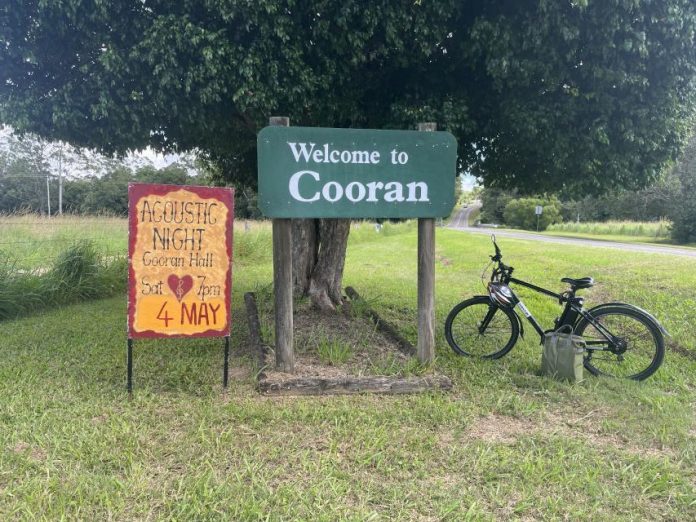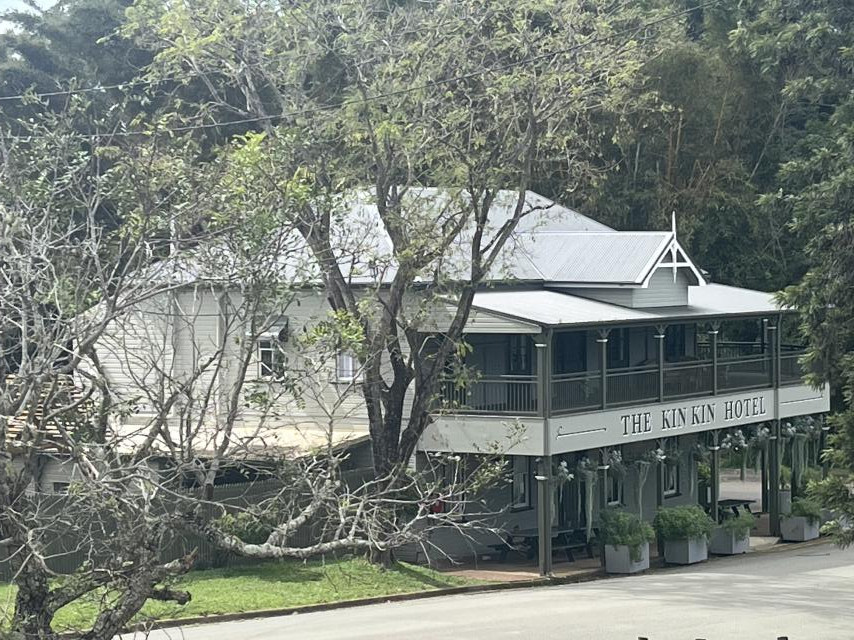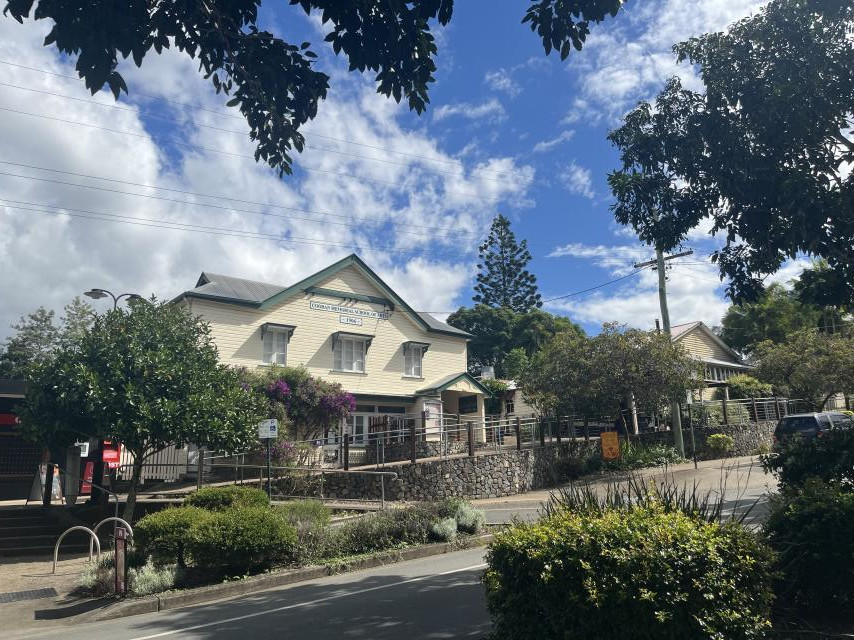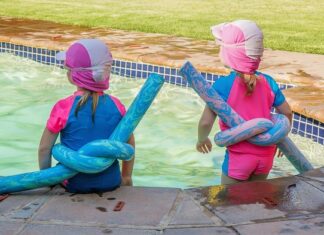PHIL JARRATT does a bit of amateur “placemaking”
My colleague Erle Levey will tell you there’s only one way to eat a meal – slow!
I would add that slow is the best way to explore Noosa Shire, which is what I did last week, putting together about the only couple of fine days we’ve had in a month for a cruisy e-cycle around the hinterland back blocks of our amazing shire. But apart from feeling the breeze on my face and getting some exercise (even with pedal assist, some of those hinterland hills are challenging for a septuagenarian), I had another objective.
A few years back, after I published my Noosa history, Place of Shadows, my friend and then new Councillor Tom Wegener came up with the idea of doing a shire tour, creating small events at bars, breweries and country halls where we’d have an important figure in Noosa history – Noel Playford, Bob Abbot, Landcare’s Phil Moran – join us for an informal chat about the past and how the hinterland villages played pass the parcel in guiding the development of out economy and governance.
These well-attended gatherings were a win/win for us, with Tom forming bonds with new and old constituents, me selling a few books and, most importantly, both of us discovering the hunger amongst newer residents for knowledge about the place they had chosen to live in. I suppose in a way, they were hungering for what we now call placemaking.
Well, that was back at the start of the Covid years, and now that has more or less passed, I wanted to get a feeling for how well our villages were blending the old and the new. Something inside me said, get on yer bike, son!
Boreen Point
After getting stuck behind a Cleanaway truck belching warm diesel in my face for most of Gympie Terrace, and the shared bike path being overrun with dog walkers in the early morning, it was a relief to get out onto the relative quiet of McKinnon Drive, although I did make a last minute decision to detour down Lake Cooroibah Road and take the loop around Woodhaven Drive, with its sprawling bungalows on acreage and the occasional slightly alarming horse head on the gate. (I know it means horses kept on the property, but I’m old enough to remember that scene in The Godfather.)
To be honest, I don’t find much in Boreen Point’s surviving architecture to inspire me, if we exclude the splendid Apollonian Hotel, which was imported from Gympie. Of course Edi Brunetti and Judy Walter’s wonderful Jetty restaurant was a huge attraction, particularly for Edi’s traditional Easter luncheon parties, most sensibly attended by chartered boat with driver, but all that fun, and sadly Edi and Judy, are long-gone.
More recently I’ve developed a passion for Coffee Tribe, down by the sailing club. But make that past tense. I arrived hanging for a triple shot espresso to find it closed forever. Fortunately a coffee cart had set up at one end of the porch rail so I could get my fix, but it wasn’t the same, even though a few hardy locals were pretending it was.
I downed my coffee and got on with my one mission at the Point, which was to locate Judith Wright’s Melaleuca, a humble cottage she named for the paperbarks that grew by the lake, and which the famous writer, poet and conservationist lived in with husband Jack McKinney and their daughter Meredith from 1953 to 1974.
I realised when I got to the corner of Vista and Urungan, why I’d never noticed Melaleuca, despite having visited a slightly famous studio just a pebble’s throw away. You can barely see it from the road, hidden by a screen of green, but it matched the fairly recent picture I’d seen of Meredith sitting on the porch that I’d seen in Sylvia Bannah’s lovely history of Boreen Point.
Local builder Bert Harms had rented a tiny holiday cottage just down the road to Jack and Judith, and when they expressed interest in buying, he directed them to a partially-built place of similar size. Judith wrote of what would be Melaleuca: “The sand [around the house] was so full of silica that it made ideal concreting material, and Bert had simply dug out a pit beside the house to build the walls … It would have two bedrooms, a good-sized kitchen with a wood stove, a bathroom with a chip heater (Boreen had no electricity yet), a laundry and (luxury) a lavatory, not a pit toilet.”
Judith loved her “little village of nine or 10 houses and a general store, all delectably perched on a lake shore above a pink and white sandstone cliff”, and was inspired to write about the characters she met there, and to become active in its environmental protection.
Kin Kin
It took me about an hour or so to ride to Kin Kin, dodging too many trucks and taking a couple of water breaks as the day warmed up, and, being about ready for another coffee and a mid-morning snack, I was alarmed to find the village closed. Well, the pub was at least. Early week closures of cafes, bars and restaurants are widespread in the hinterland, but since the old Country Life reopened last year after being complete closed for more than a year, owners David and Ellie Ezrine (who bought it with Matthew Flynn for $1.1 million in 2021) have scaled back to around three days a week, built around the weekend trade, which seems a little odd, given the number of village stalkers you find roaming around midweek.
Apparently reduction is catchy, because the Black Ant café up the hill, which used to offer great gourmet lunches, now has a much reduced breakfast/brunch menu and then closes.
But, you know, when in Kin Kin … I ordered a coffee and croissant and made myself comfortable on the airy verandah overlooking the empty street. It’s a beautiful place and it’s a shame to see it lying somewhat idle, but it wouldn’t be the first time.
Established as a service town for the logging industry in 1902, it later turned to dairy and pioneered the co-op system in the new Noosa Shire, and still later moved over to a briefly-thriving banana industry. But then the town went very quiet for decades until it was rediscovered by tree-changers and new generation small croppers. While it seems to be slightly suffering the monopoly blues at the moment, not to mention the quarry traffic, it’s too beautiful to escape notice, and I’m sure the revival is imminent.
Cooran
Another hour’s ride dodging trucks and now it was seriously time for a pub lunch, and in Cooran I knew that meant the Hinterland Brewery. Closed Tuesdays! There was a snack bar open down the hill but it didn’t entice, so I decided to hang out for a late lunch in Pomona and earn it by exploring Cooran’s heritage walk along the King Street commercial precinct, or what still exists on the western side, opposite the railway station.
I have to admit that this is my favoured hinterland village, both for its rich history which you can still see, and the dramtic beauty of neighbouring Pinbarren. Tewantin was the first township surveyed in 1871 within what would become Noosa Shire, but Cooran was the first of the three hinterland villages to be established which would later vie for the seat of economic development, and later, the seat of local governance. This happened because pioneer Walter Hay’s “shortcut” between the port of Tewantin and the Gympie goldfields went right through it, and the Martin family’s Halfway House inn became a staging point for the Cobb and Co coach service.
Less than 20 years later Cooran had the region’s earliest and most important railway station, which opened in 1889, connecting it to Gympie and making the tiny village a popular early tourist destination. Taking advantage of this, Bill Martin demolished the ramshackle Halfway House and built the Railway Hotel, which retained stables out the back, just in case, but was the “epitome of modernity”, with electric lights through its reception, dining room and bar and 10 bedrooms upstairs.
The Railway Hotel burnt down in 1965 and the site is now a playground, but much of the King Street commercial strip remains, and as I set off on my walk I realised I was standing in front of one of the more interesting pieces – the closed Hinterland Brewery, which still bears the name of its former occupants, Alfredson’s Joinery.
Established as Alfredson’s woodworking shop in 1933, this operation expanded from 1946 to include a sawmill which specialised in producing pre-cut homes. Mervyn Alfredson, who had apprenticed as a cabinetmaker at Page Furnishings in Pomona, devised his system of pre-cut frames, the forerunner of pre-fab homes, from reading journals. The business became quite big, with his pre-cut house materials were bundled together and despatched on rail cars from Cooran Station.
At the second-most interesting building on the strip, the Memorial School of Arts, built 1906, I was drawn into the building by the beautiful harmonies of a choir. A group of about 20 middle-aged to elderly residents, they were magnificent. As I snuck out and made my way back to my bike, a tiny elderly lady ran out and shouted, “Would you like to join our choir?”
Unable to hold a note, I deemed it time to make my escape.
Next week, the ride continues, to the power bases of the hinterland.















